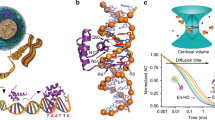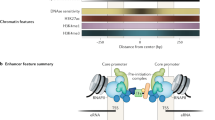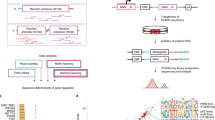Abstract
We describe methods for generating artificial transcription factors capable of up- or downregulating the expression of genes whose promoter regions contain the target DNA sequences. To accomplish this, we screened zinc fingers derived from sequences in the human genome and isolated 56 zinc fingers with diverse DNA-binding specificities. We used these zinc fingers as modular building blocks in the construction of novel, sequence-specific DNA-binding proteins. Fusion of these zinc-finger proteins with either a transcriptional activation or repression domain yielded potent transcriptional activators or repressors, respectively. These results show that the human genome encodes zinc fingers with diverse DNA-binding specificities and that these domains can be used to design sequence-specific DNA-binding proteins and artificial transcription factors.
This is a preview of subscription content, access via your institution
Access options
Subscribe to this journal
Receive 12 print issues and online access
$209.00 per year
only $17.42 per issue
Buy this article
- Purchase on Springer Link
- Instant access to full article PDF
Prices may be subject to local taxes which are calculated during checkout



Similar content being viewed by others
References
Brent, R. & Ptashne, M.A. Eukaryotic transcriptional activator bearing the DNA specificity of a prokaryotic repressor. Cell 43, 729–736 (1985).
Rebar, E.J. & Pabo, C.O. Zinc-finger phage: affinity selection of fingers with new DNA-binding specificities. Science 263, 671–673 (1994).
Jamieson, A.C., Kim, S.-H. & Wells, J.A. In vitro selection of zinc fingers with altered DNA-binding specificity. Biochemistry 33, 5689–5695 (1994).
Choo, Y. & Klug, A. Toward a code for the interactions of zinc fingers with DNA: selection of randomized fingers displayed on phage. Proc. Natl. Acad. Sci. 91, 11163–11167 (1994).
Wu, H., Yang, W.P. & Barbas, C.F. III. Building zinc fingers by selection: toward a therapeutic application. Proc. Natl. Acad. Sci. USA 92, 344–348 (1995).
Greisman, H.A. & Pabo, C.O. A general strategy for selecting high-affinity zinc-finger proteins for diverse DNA target sites. Science 275, 657–661 (1997).
Isalan, M., Klug, A. & Choo, Y. A rapid, generally applicable method to engineer zinc fingers illustrated by targeting the HIV-1 promoter. Nat. Biotechnol. 19, 656–660 (2001).
Wang, M.M. & Reed, R.R. Molecular cloning of the olfactory neuronal transcription factor Olf-1 by genetic selection in yeast. Nature 364, 121–126 (1993).
Cheng, X., Boyer, J.L. & Juliano, R.L. Selection of peptides that functionally replace a zinc finger in the Sp1 transcription factor by using a yeast combinatorial library. Proc. Natl. Acad. Sci. USA 94, 14120–14125 (1997).
Bartsevich, V.V. & Juliano, R.L. Regulation of the MDR1 gene by transcriptional repressors selected using peptide combinatorial libraries. Mol. Pharmacol. 58, 1–10 (2000).
Desjarlais, J.R. & Berg, J.M. Redesigning the DNA-binding specificity of a zinc-finger protein: a data base–guided approach. Proteins Struct. Funct. Genet. 12, 101–104 (1992).
Choo, Y. & Klug, A. Physical basis of a protein-DNA recognition code. Curr. Opin. Struct. Biol. 7, 117–125 (1997).
Wolfe, S.A., Greisman, H.A., Ramm, E.I. & Pabo, C.O. Analysis of zinc fingers optimized via phage display: evaluating the utility of a recognition code. J. Mol. Biol. 285, 1917–1934 (1998).
Pavletich, N.P. & Pabo, C.O. Zinc finger–DNA recognition: crystal structure of a Zif268-DNA complex at 2. 1Å. Science 252, 809–817 (1991).
Elrod-Erickson, M., Benson, T.E. & Pabo, C.O. High-resolution structures of variant Zif268-DNA complexes: implications for understanding zinc finger–DNA recognition. Structure 6, 451–464 (1998).
Wolfe, S.A., Grant, R.A., Elrod-Erickson, M. & Pabo, C.O. Beyond the 'recognition code': structures of two Cys2His2 zinc finger/TATA box complexes. Structure 8, 717–723 (2001).
Pabo, C.O., Peisach, E. & Grant, R.A. Design and selection of novel Cys2His2 zinc-finger proteins. Annu. Rev. Biochem. 70, 313–340 (2001).
Segal, D.J., Dreier, B., Beerli, R.R. & Barbas, C.F. III. Toward controlling gene expression at will: selection and design of zinc-finger domains recognizing each of the 5′-GNN-3′ DNA target sequences. Proc. Natl. Acad. Sci. USA 96, 2758–2763 (1999).
Dreier, B., Beerli, R.R., Segal, D.J., Flippin, J.D. & Barbas, C.F. III. Development of zinc-finger domains for recognition of the 5′-ANN-3′ family of DNA sequences and their use in the construction of artificial transcription factors. J. Biol. Chem. 276, 29466–29478 (2001).
Choo, Y. & Klug, A. Selection of DNA binding sites for zinc fingers using rationally randomized DNA reveals coded interactions. Proc. Natl. Acad. Sci. USA 91, 11168–11172 (1994).
Desjarlais, J.R. & Berg, J.M. Length-encoded multiplex binding site determination: application to zinc-finger proteins. Proc. Natl. Acad. Sci. USA 91, 11099–11103 (1994).
Liu, Q., Xia, Z. & Case, C.C. Validated zinc-finger protein designs for all 16 GNN DNA triplet targets. J. Biol. Chem. 277, 3850–3856 (2002).
Sera, T. & Uranga, C. Rational design of artificial zinc-finger proteins using a nondegenerate recognition code table. Biochemistry 41, 7074–7081 (2002).
Kim, J.-S. & Pabo, C.O. Transcriptional repression by zinc-finger peptides: exploring the potential for applications in gene therapy. J. Biol. Chem. 272, 29795–29800 (1997).
Kim, J.-S. & Pabo, C.O. Getting a handhold on DNA: design of poly-zinc-finger proteins with femtomolar dissociation constants. Proc. Natl. Acad. Sci. USA 95, 2812–2817 (1998).
Kang, J.S. & Kim, J.-S. Zinc-finger proteins as designer transcription factors. J. Biol. Chem. 275, 8742–8748 (2000).
Liu, P.Q. et al. Regulation of an endogenous locus using a panel of designed zinc-finger proteins targeted to accessible chromatin regions. J. Biol. Chem. 276, 11323–11334 (2001).
Nardelli, J., Gibson, T. & Charnay, P. Zinc finger–DNA recognition: analysis of base specificity by site-directed mutagenesis. Nucleic Acids Res. 20, 4137–4144 (1992).
Taylor, W.E. et al. Designing zinc-finger ADR1 mutants with altered specificity of DNA binding to T in UAS1 sequences. Biochemistry 34, 3222–3230 (1995).
Joung, J.K., Ramm, E.I. & Pabo, C.O. A bacterial two-hybrid selection system for studying protein-DNA and protein-protein interactions. Proc. Natl. Acad. Sci. USA 97, 7382–7387 (2000).
Beerli, R.R., Dreier, B. & Barbas, C.F. III. Positive and negative regulation of endogenous genes by designed transcription factors. Proc. Natl. Acad. Sci. USA 97, 1495–1500 (2000).
Zhang, L. et al. Synthetic zinc-finger transcription factor action at an endogenous chromosomal site. Activation of the human erythropoietin gene. J. Biol. Chem. 275, 33850–33860 (2000).
Ren, D., Collingwood, T.N., Rebar, E.J., Wolffe, A.P. & Camp, H.S. PPARγ knockdown by engineered transcription factors: exogenous PPARγ2 but not PPARγ1 reactivates adipogenesis. Genes Dev. 16, 27–32 (2002).
Chevray, P.M. & Nathans, D. Protein interaction cloning in yeast: identification of mammalian proteins that interact with the leucine zipper of Jun. Proc. Natl. Acad. Sci. USA 89, 5789–5793 (1992).
Hudson, J.R. et al. The complete set of predicted genes from Saccharomyces cerevisiae in a readily usable form. Genome Res. 7, 1169–1173 (1997).
Acknowledgements
We thank Randall Reed for providing yeast strain yWAM2 and plasmids pRS315HIS and pPC86. We also thank S.I. Lee, S.I. Kim, J.W. Kim, and H.R. Lee for technical assistance and K. LaMarco for carefully reading our manuscript. This study was supported by a grant of the National Research Laboratory Program from the Ministry of Science & Technology, Republic of Korea (M1-0104-00-0048).
Author information
Authors and Affiliations
Corresponding author
Ethics declarations
Competing interests
The research described in the paper was at least partially funded by ToolGen, Inc., a privately-held company, and most of the authors are employees of ToolGen, Inc. J.-S. K. is one of the co-founders of the company and is a major shareholder.
Supplementary information
Supplementary Figure 1.
Zinc “fingerprints”. The DNA-binding specificities of selected zinc fingers fused to fingers 1 and 2 of Zif268 were determined in yeast cells using 64 LacZ reporter sets, each of which contained one of the 64 triplet subsites. “+” indicates a positive control that contains the third finger of Zif268 and a reporter plasmid containing its subsite sequence, GCG. “−” indicates a negative control that contains only the first and second fingers of Zif268 and a control reporter plasmid that lacks the Zif268 binding sequence. (PDF 20 kb)
Supplementary Figure 2.
Nucleotide sequence of the polylinker site of the P3 expression plasmid and the construction of plasmids encoding chimeric 3-finger proteins. (A) Nucleotide sequence of the polylinker site of the P3 expression plasmid. (B) The DNA encoding each zinc finger domain was cloned into the P3 vector to form “single finger” vectors. Equal amounts of each “single finger” vector were combined to form a pool. The pool was separately digested with two sets of enzymes: AgeI and XhoI, and XmaI and XhoI. After phosphatase treatment for 30 min, vectors from the AgeI and XhoI digested pool were ligated to the nucleic acid segments released from the vector by the XmaI and XhoI digestion. These segments each encode a single zinc finger domain. Ligation of the nucleic acid segments to the digested vector formed vectors that encode two zinc finger domains. After transformation into E. coli, the ligation products yielded ˜1.4 × 104 transformants, thereby forming a 2-finger library. Subsequently, the 2-finger library was digested with AgeI and XhoI. The digested vector, which retains the nucleic acid sequences encoding two zinc finger domains, was ligated to the pool of 1-finger fragments prepared as above by digestion with XmaI and XhoI. The products of this ligation were transformed into E. coli to yield about 2.4 × 105 independent transformants, and a library of plasmids encoding 3-finger proteins was isolated from the transformants. ZF1, one-finger protein; ZF2, two-finger protein; ZF3, three-finger protein. The arrows indicate the coding regions of ZF1-ZF3. (PDF 42 kb)
Supplementary Figure 3.
Promoters of reporter constructs used in transfection analyses. The DNA sequences of the reporter constructs are aligned to show the location of the zinc finger binding sites. The upper line (Control plasmid) shows the sequence of the synthetic promoter containing the initiator element, and bases are numbered with respect to the start of transcription. In the lower, reporter plasmid sequence, NNNNNNNNN indicates a cognate binding site for the specific ZFP. Identical nucleotides are shown as “−”, and a blank means that the corresponding nucleotide is deleted. An oligomer containing the specific 9-bp binding site for each ZFP replaced the 14-bp segment located 12-bp downstream from the transcription start site in the control plasmid. (PDF 21 kb)
Supplementary Figure 4.
Western blot analysis. Plasmids encoding representative ZFPs were transfected into HEK293 cells. After growing the cells in culture for 2 days, protein extracts were prepared and analyzed by Western blotting. These ZFPs and their fold repression values are described in Supplementary Table 2. The numbers of engineered zinc fingers and human zinc fingers that constitute these three-finger ZFPs are indicated. (PDF 960 kb)
Rights and permissions
About this article
Cite this article
Bae, KH., Do Kwon, Y., Shin, HC. et al. Human zinc fingers as building blocks in the construction of artificial transcription factors. Nat Biotechnol 21, 275–280 (2003). https://doi.org/10.1038/nbt796
Received:
Accepted:
Published:
Issue Date:
DOI: https://doi.org/10.1038/nbt796
This article is cited by
-
Design principles for synthetic control systems to engineer plants
Plant Cell Reports (2023)
-
Orthogonal control of gene expression in plants using synthetic promoters and CRISPR-based transcription factors
Plant Methods (2022)
-
Transcription factor stoichiometry in cell fate determination
Journal of Genetics (2021)
-
Genome editing of oncogenes with ZFNs and TALENs: caveats in nuclease design
Cancer Cell International (2018)
-
An ensemble micro neural network approach for elucidating interactions between zinc finger proteins and their target DNA
BMC Genomics (2016)



